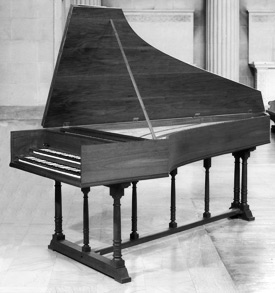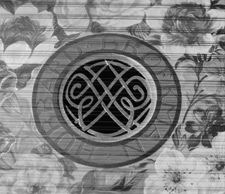After
J. D. Dulcken
 The
influence of the Ruckers was felt long into the 18th century, not only
in France and England, but in the Netherlands as well. One of the most
fascinating bodies of instruments left to us from this time comes from
the hands of Johann Daniel Dulcken. Dulcken took the basic Ruckers design,
which had not been produced in many decades, and enlarged it out of
all proportion to the product of any other contemporary maker. The effect
of this novel design decision was to make an instrument that did not
display the same differences of tone from bass to treble that one finds
in other 18th century doubles. Rather, these immense instruments (they
are eight and one half feet long) have a crystalline sound that, paradoxically,
combines the clarity of the best Italian harpsichords and the sustained
tone of a Ruckers. They excel at contrapuntal playing although we have
heard them used to admirable effect in late 18th century French music
as well. The disposition is oriented more toward the organist and is
thus more flexible than any other type of instrument produced at the
time.
The
influence of the Ruckers was felt long into the 18th century, not only
in France and England, but in the Netherlands as well. One of the most
fascinating bodies of instruments left to us from this time comes from
the hands of Johann Daniel Dulcken. Dulcken took the basic Ruckers design,
which had not been produced in many decades, and enlarged it out of
all proportion to the product of any other contemporary maker. The effect
of this novel design decision was to make an instrument that did not
display the same differences of tone from bass to treble that one finds
in other 18th century doubles. Rather, these immense instruments (they
are eight and one half feet long) have a crystalline sound that, paradoxically,
combines the clarity of the best Italian harpsichords and the sustained
tone of a Ruckers. They excel at contrapuntal playing although we have
heard them used to admirable effect in late 18th century French music
as well. The disposition is oriented more toward the organist and is
thus more flexible than any other type of instrument produced at the
time.
18th century
Flemish double after J. D. Dulcken – Offering
Sheet
Listen
to it...
You
can hear an excerpt from a demonstration
CD we have prepared for this instrument:
~
A Note About The Files ~
Not all mp3 files are equal! The sound of a harpsichord is
particularly difficult to compress satisfactorily. The bit rate
we have chosen for these samples is the lowest that reproduces the
original recording with negligible loss. Download times will
vary widely depending on your setup and the quality of your connection.
On a 28K Internet connection, the shorter sound sample may
take from about 5 to over 10 minutes to download. If you have a
fast connection (T1, cable modem, DSL) please try the long sample
- you may expect download times substantially under a minute.
~ Problems Playing the File ~
If you cannot play the file through your web browser, PC users with
the Microsoft browser can right click on the link, then choose the
"Save target" option to download the file, then use an
MP3 player (or a the Windows media player) to listen to it.
We now
have available a demonstration CD
of the instrument after J. D. Dulcken ($10.00 ppd. in U.S.). Please
- inquire via our contact form.
